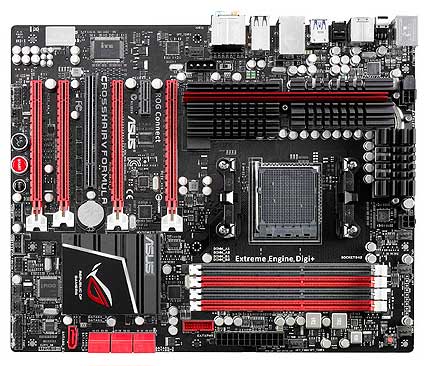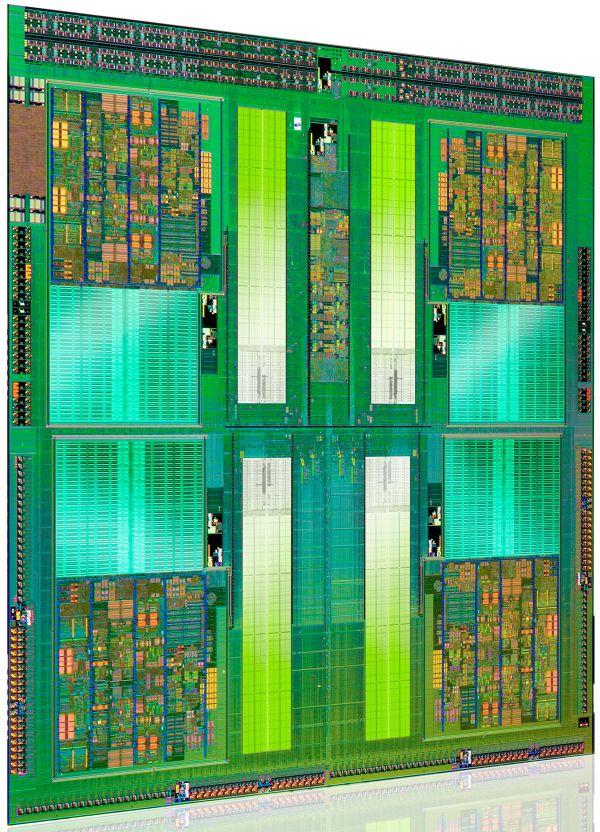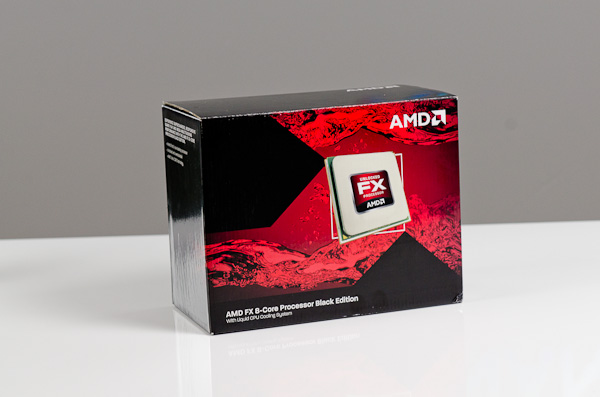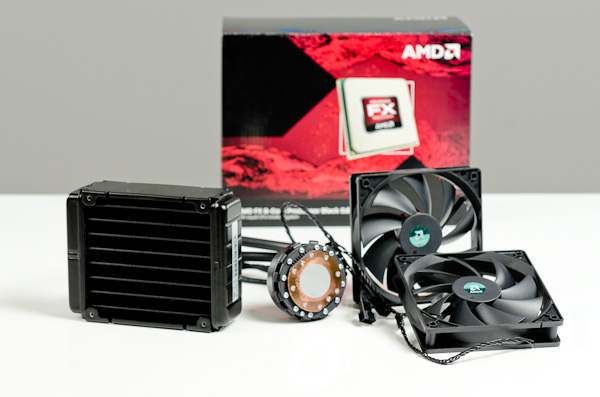The Bulldozer Review: AMD FX-8150 Tested
by Anand Lal Shimpi on October 12, 2011 1:27 AM ESTAMD has been trailing Intel in the x86 performance space for years now. Ever since the introduction of the first Core 2 processors in 2006, AMD hasn't been able to recover and return to the heyday of the Athlon 64 and Athlon 64 X2. Instead the company has remained relevant by driving costs down and competing largely in the sub-$200 microprocessor space. AMD's ability to hold on was largely due to its more-cores-for-less strategy. Thanks to aggressive pricing on its triple and hexa-core parts, for users who needed tons of cores, AMD has been delivering a lot of value over the past couple of years.
Recently however Intel has been able to drive its per-core performance up with Sandy Bridge, where it's becoming increasingly difficult to recommend AMD alternatives with higher core counts. The heavily threaded desktop niche is tough to sell to, particularly when you force users to take a significant hit on single threaded performance in order to achieve value there. For a while now AMD has needed a brand new architecture, something that could lead to dominance in heavily threaded workloads while addressing its deficiencies in lightly threaded consumer workloads. After much waiting, we get that new architecture today. Bulldozer is here.
It's branded the AMD FX processor and it's only available in a single die configuration. Measuring 315mm2 and weighing in at around 2 billion transistors (that's nearly GPU-sized fellas), Bulldozer isn't that much smaller than existing 45nm 6-core Phenom II designs despite being built on Global Foundries' 32nm SOI process. Both die area and transistor count are up significantly over Sandy Bridge, which on Intel's 32nm HKMG process is only 995M transistors with a die size of 216mm2. This is one big chip.
| CPU Specification Comparison | ||||||||
| CPU | Manufacturing Process | Cores | Transistor Count | Die Size | ||||
| AMD Bulldozer 8C | 32nm | 8 | 1.2B* | 315mm2 | ||||
| AMD Thuban 6C | 45nm | 6 | 904M | 346mm2 | ||||
| AMD Deneb 4C | 45nm | 4 | 758M | 258mm2 | ||||
| Intel Gulftown 6C | 32nm | 6 | 1.17B | 240mm2 | ||||
| Intel Nehalem/Bloomfield 4C | 45nm | 4 | 731M | 263mm2 | ||||
| Intel Sandy Bridge 4C | 32nm | 4 | 995M | 216mm2 | ||||
| Intel Lynnfield 4C | 45nm | 4 | 774M | 296mm2 | ||||
| Intel Clarkdale 2C | 32nm | 2 | 384M | 81mm2 | ||||
| Intel Sandy Bridge 2C (GT1) | 32nm | 2 | 504M | 131mm2 | ||||
| Intel Sandy Bridge 2C (GT2) | 32nm | 2 | 624M | 149mm2 | ||||
Update: AMD originally told us Bulldozer was a 2B transistor chip. It has since told us that the 8C Bulldozer is actually 1.2B transistors. The die size is still accurate at 315mm2.
Architecturally Bulldozer is a significant departure from anything we've ever seen before. We'll go into greater detail later on in this piece, but the building block in AMD's latest architecture is the Bulldozer module. Each module features two integer cores and a shared floating point core. FP hardware is larger and used less frequently in desktop (and server workloads), so AMD decided to share it between every two cores rather than offer a 1:1 ratio between int/fp cores on Bulldozer. AMD advertises Bulldozer based FX parts based on the number of integer cores. Thus a two module Bulldozer CPU, has four integer cores (and 2 FP cores) and is thus sold as a quad-core CPU. A four module Bulldozer part with eight integer cores is called an eight-core CPU. There are obvious implications from a performance standpoint, but we'll get to those shortly.
The FX Lineup
There are a total of 7 AMD FX CPUs that AMD is announcing today, although only four are slated for near-term availability.
| CPU Specification Comparison | |||||||||
| Processor | Cores | Clock Speed | Max Turbo | NB Clock | L2 Cache | TDP | Price | ||
| AMD FX-8150 | 8 | 3.6GHz | 4.2GHz | 2.2GHz | 8MB | 125W | $245 | ||
| AMD FX-8120 | 8 | 3.1GHz | 4.0GHz | 2.2GHz | 8MB | 95W/125W | $205 | ||
| AMD FX-8100* | 8 | 2.8GHz | 3.7GHz | 2GHz | 8MB | 95W | N/A | ||
| AMD FX-6100 | 6 | 3.3GHz | 3.9GHz | 2GHz | 6MB | 95W | $165 | ||
| AMD FX-4170* | 4 | 4.2GHz | 4.3GHz | 2.2GHz | 4MB | 125W | N/A | ||
| AMD FX-B4150* | 4 | 3.8GHz | 4GHz | 2.2GHz | 4MB | 95W | N/A | ||
| AMD FX-4100 | 4 | 3.6GHz | 3.8GHz | 2GHz | 4MB | 95W | $115 | ||
| AMD Phenom II X6 1100T | 6 | 3.2GHz | 3.6GHz | 2GHz | 3MB | 125W | $190 | ||
| AMD Phenom II X4 980 | 4 | 3.7GHz | N/A | 2GHz | 2MB | 125W | $170 | ||
The FX-8150, 8120, 6100 and 4100 are what's launching today. The first digit in AMD's FX model numbers indicates the number of cores with the 8150 and 8120 boasting eight, while the 6100 only has six active integer cores (three Bulldozer modules). The FX-4100 features four integer cores. L2 cache scales with core count (2MB per module), while the L3 cache size remains fixed at 8MB regardless of SKU.
North Bridge and L3 cache frequency alternate between 2.0GHz and 2.2GHz depending on the part. TDPs range between 95W and 125W as well, with the FX-8120 being offered in both 125W and 95W versions.
There's only a single Bulldozer die. The 6 and 4 core versions simply feature cores disabled on the die. AMD insists this time around, core unlocking won't be possible on these harvested parts.
The huge gap in clock speed between the 8120 and 8150 are troubling. Typically we see linear frequency graduations but the fact that there's a 16% difference between these two SKUs seems to point to process problems limiting yield at higher frequencies—at least for the 8-core version.
Outside of the quad-core and hex-core Bulldozer pats, the only other FX processor able to exceed the 3.3GHz clock speed of the Phenom II X6 1100T is the 8150. And if you include quad-core Phenom II parts in the mix, only two Bulldozer parts ship at a higher stock frequency than the Phenom II X4 980. Granted Turbo Core will help push frequencies even higher, but these low base frequencies are troubling. For an architecture that was designed to scale to clock speeds 30% higher than its predecessor, Bulldozer doesn't seem to be coming anywhere close.
The entire FX lineup ships unlocked, which allows for some easy overclocking as you'll see soon enough.
Motherboard Compatibility
AMD is certifying its FX processors for use on Socket-AM3+ motherboards. Owners of standard AM3 motherboards may be out of luck, although motherboard manufacturers can choose to certify their boards for use with Bulldozer if they wish to do so. From AMD's perspective however, only AM3+ motherboards with BIOS/UEFI support for Bulldozer are officially supported.
All existing AM2/AM2+/AM3/AM3+ heatsinks should work with the FX processor; they simply need to be rated for the TDP of the processor you're looking to cool.

For this review, AMD supplied us with ASUS' Crosshair V Formula AM3+ motherboard based on AMD's 990FX chipset.
AMD does offer six 6Gbps SATA ports on its 990FX chipset, a significant upgrade from the two 6Gbps ports on Intel's 6-series chipsets. Unbuffered ECC memory is also supported for those who desire the added security, once again a feature not supported on Intel's consumer grade 6-series chipsets.
Despite AMD's trend towards releasing APUs with integrated GPUs (thus requiring a new socket), AMD insists that the AM3+ platform will live to see one more processor generation before it's retired.
AMD's Liquid CPU Cooling System
Alongside its new FX processors AMD is introducing its first branded liquid cooling system manufactured by Asetek.
AMD's cooling system is similar to other offerings from companies like Antec and Corsair. The system is self contained, you never have to worry about adding any more liquid to it.
Attach the cooling module to your CPU socket via a simple bracket, and affix the radiator to your case and you're good to go. The radiator is cooled via two 120mm fans, also included in the box.
AMD doesn't have an exact idea on pricing or availability of its liquid cooling solution, but I'm told to expect it to be around $100 once available. My sample actually arrived less than 12 hours ago, so expect a follow up with performance analysis later this week.
The Roadmap
For the first time in far too long, AMD is actually being very forthcoming about its future plans. At a recent tech day about Bulldozer, AMD laid out its CPU core roadmap through 2014. The code names are below:
Piledriver you already know about, it's at the heart of Trinity, which is the 2—4 core APU due out in early 2012. Piledriver will increase CPU core performance by around 10—15% over Bulldozer, although it will initially appear in a lower performance segment. Remember that final generation of AM3+ CPU I mentioned earlier? I fully expect that to be a GPU-less Piledriver CPU due out sometime in 2012.
Steamroller will follow in 2013, again improving performance (at the core level) by around 10—15%. Excavator will do the same in 2014. AMD believes that these performance increases will be sufficient to keep up with Intel over time, however I'll let you be the judge of that once we get to the Bulldozer performance numbers.
The other thing to note about AMD's roadmap is it effectively puts the x86 business on an annual cadence, in line with what we've seen from the AMD GPU folks. Although AMD isn't talking about what process nodes to expect all of these cores at, it looks like AMD will finally have an answer to Intel's tick-tock release schedule moving forward.























430 Comments
View All Comments
ET - Wednesday, October 12, 2011 - link
I gather you're trying for a job at AMD.wolfman3k5 - Wednesday, October 12, 2011 - link
Even the most hardcore AMD Fanboys are having a hard time defending this bulldozed Bulldozer chip.I have seen people blaming anything from Global Foundries to saying that "It's not all that bad."
If you're an AMD Fanboy in Denial, you should read what's wrong wigt Bulldozer:
1) AMD's marketing is extremely misleading, because Bulldozer is not more of a Quad Core chip than Intel's Core i7 for example. What AMD did was to create a crude implementation of CMT (chip-level multithreading), which is debatable as of now if it's any better than Intel's Hyper Threading, with the mention that Hyper Threading takes less than 5% of DIE Space per Core. Basically each Module (as AMD likes to call its Cores now) has an additional Integer Unit, but the problem is that the additional Integer Unit shares the Fetch and Decode units with the other Integer Unit in the Module. Ergo, the CPU is not a true 8 Core. It is just a cheap AMD marketing gimmick.
2) The reason for the horrendous single threaded performance is the poor design of the Integer units in the modules (you can interpret this as very low IPC count). Couple that with the fact that two Integer Units share the same Fetch and Decode units, and when one additional thread is added that screws things up and the pipeline needs to be flushed, it messes things up for the other Integer Unit as well. At a bare minimum AMD should have added a Fetch and Decode unit for each Integer Unit. But wait, if they would have done that, then they would have needed to add a dedicated FPU for each separated Integer unit. Hell, this is almost worst than Hyper Threading. At least Hyper Threading makes use of unused resources in the CPU. AMD's implementation can leave resources unused.
Bottom line: no matter how you slice and dice it, the Bulldozer chip cannot be called an 8 core chip. It's a 4 Core CPU with CMT.
3) In order to compensate for the design flaws in each Module (what I've described in point no. 2), AMD increased the L2 cache to almost absurd levels for each module, to mask some of the latency created by their poor CMT implementation. Intel's Sandy Bridge does away with 256KB L2 cache per core. Hence, we have ~1.6 Billion Transistors in Bulldozer, which creates leakage, which in turn translates into high power draw. Those of you that defended this failure of a CPU claiming that it was designed for servers should know that Performance / Watt is all that matters for servers, because you run into cooling issues otherwise, which translate into high energy costs both for the servers themselves and for the cooling which is done mostly by Air Conditioning. And we all know that Air Conditioning draws lots of electricity.
Bottom line: it's not Global Foundries fault, it's AMD's fault for not designing a more efficient CPU with less transistors (Sandy Bridge quad core has ~1.12 Billion).
Belard - Wednesday, October 12, 2011 - link
Those are excellent points.Its like AMD decided to DO EVERYTHING wrong that Intel and Nvidia did and put it all onto a single chip!!
The Fusion CPUs provided small size, good performance and excellent GPU at a good price. Bulldog is a mutt of a mess.
Brinip - Wednesday, October 12, 2011 - link
After years of being an avid amd fan. I finally switched this year to Intels sandybridge CPU. Amd could no longer compeat with the pure power of the sandybridge core.I was really hoping the bulldozer would re-write the books and put amd back on an even footing. In some ways they have re- written the books as the architecture of the new CPU is quite a change, however for now at least they don't pose ant threat to Intels superb sandybridge core.
Not only are sandybridge CPUs fast, they are also fairly low power and run very cool. What more can you say really. Fast, cool and efficient.
Perhaps as amd develop it further then improvement may come, however don't expect intel to sit still either.
LordConrad - Wednesday, October 12, 2011 - link
Looks like AMD jumped on the NetBurst bandwagon. My next computer build will be Intel.Artas1984 - Wednesday, October 12, 2011 - link
QUOTE:I was hoping for Bulldozer to address AMD's weakness rather than continue to just focus on its strengths
UNQUOTE
And while the new chip does feature a slight improvement in mutli-threaded apps, it's pound per pound performance is slower than AMD Phenom II X6 1100T
8 core, 32 nm, 8 Mb L2, 3600 MHz CPU SLOWER than 6 core, 45 nm, 3 Mb L2, 3300 MHz!!!
Seriously...
W H A T T H E F U ^ K I S T H I S S H I T???
But it's not a big deal. There are greater problems in this world that cpu debates. At least we have AMD and Intel. Imagine if there was only one company making processors - my god that would be a problem then...
ClagMaster - Wednesday, October 12, 2011 - link
The Bulldozer would be a dynamite server processor provided the OS was optimized for the cores that are available.I think the processor has real potential but needs further optimization with a latter stepping.
As for PC useage, performance of the FX-8150 is not bad but I could do better with an i7-2500. I am a low power person and if I were opting for a PC upgrade tonight at NEWEGG, I would choose the i5 2400S and a X68 Intel motherboard.
jaygib9 - Wednesday, October 12, 2011 - link
I don't know about the rest of you, but personally, if I'm going with an 8 core CPU, I'd go water cooling anyhow. Air cooled pc's should be on their deathbed and water cooling should be the norm. AMD and Intel are leaving more CPU's unlocked for overclocking anyhow. What do you think the performance would look like at 5 GHz/core compared to stock speeds?jaygib9 - Wednesday, October 12, 2011 - link
Personally I wonder if soon they'll require water cooling and quit worrying so much about the TDP(within reason of course), then they can concentrate on the clock speed.Belard - Thursday, October 13, 2011 - link
Geee... a 25% overclock for the fake 8-core CPU will not make up for the 30~50% performance disadvantage over a cheaper $200 intel CPU.THAT is a serious problem.
Water cooling is stupid, in general. Less than 1% of desktop computers have water cooling. They will fail sooner or later.